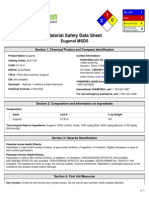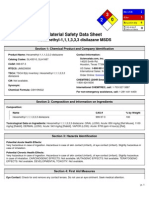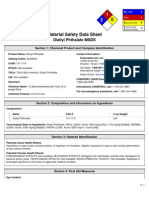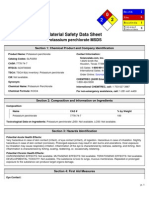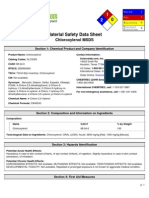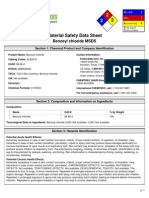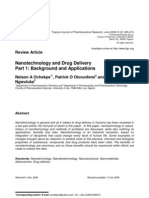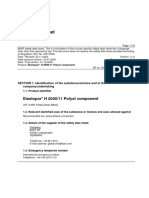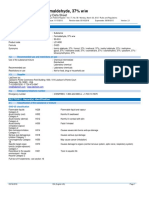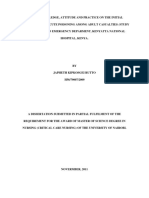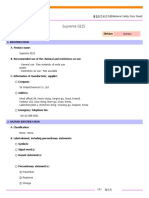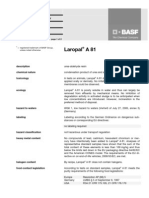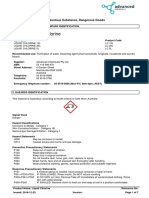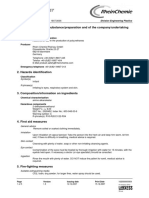Cinna Mal de Hide
Cinna Mal de Hide
Uploaded by
rully1234Copyright:
Available Formats
Cinna Mal de Hide
Cinna Mal de Hide
Uploaded by
rully1234Original Description:
Copyright
Available Formats
Share this document
Did you find this document useful?
Is this content inappropriate?
Copyright:
Available Formats
Cinna Mal de Hide
Cinna Mal de Hide
Uploaded by
rully1234Copyright:
Available Formats
2 2
Material Safety Data Sheet
trans-Cinnamaldehyde MSDS
Section 1: Chemical Product and Company Identification
Product Name: trans-Cinnamaldehyde Catalog Codes: SLC1147 CAS#: 104-55-2 RTECS: GD6475000 TSCA: TSCA 8(b) inventory: trans-Cinnamaldehyde CI#: Not available. Synonym: trans-3-Phenyl-2-propenal Chemical Formula: C9H8O Contact Information: Sciencelab.com, Inc. 14025 Smith Rd. Houston, Texas 77396 US Sales: 1-800-901-7247 International Sales: 1-281-441-4400 Order Online: ScienceLab.com
He a lt h
2 2 0 H
Fire Re a c t iv it y P e rs o n a l P ro t e c t io n
CHEMTREC (24HR Emergency Telephone), call: 1-800-424-9300 International CHEMTREC, call: 1-703-527-3887 For non-emergency assistance, call: 1-281-441-4400
Section 2: Composition and Information on Ingredients
Composition: Name {trans-}Cinnamaldehyde CAS # 104-55-2 % by Weight 100
Toxicological Data on Ingredients: trans-Cinnamaldehyde: ORAL (LD50): Acute: 2220 mg/kg [Rat]. 1160 mg/kg [Guinea pig].
Section 3: Hazards Identification
Potential Acute Health Effects: Very hazardous in case of ingestion. Hazardous in case of skin contact (irritant), of eye contact (irritant), of inhalation. Potential Chronic Health Effects: Very hazardous in case of ingestion. Hazardous in case of skin contact (irritant), of eye contact (irritant), of inhalation. CARCINOGENIC EFFECTS: Not available. MUTAGENIC EFFECTS: Not available. TERATOGENIC EFFECTS: Not available. DEVELOPMENTAL TOXICITY: Not available. The substance is toxic to mucous membranes. Repeated or prolonged exposure to the substance can produce target organs damage.
Section 4: First Aid Measures
Eye Contact: p. 1
Check for and remove any contact lenses. Immediately flush eyes with running water for at least 15 minutes, keeping eyelids open. Cold water may be used. Do not use an eye ointment. Seek medical attention. Skin Contact: After contact with skin, wash immediately with plenty of water. Gently and thoroughly wash the contaminated skin with running water and non-abrasive soap. Be particularly careful to clean folds, crevices, creases and groin. Cover the irritated skin with an emollient. If irritation persists, seek medical attention. Wash contaminated clothing before reusing. Serious Skin Contact: Wash with a disinfectant soap and cover the contaminated skin with an anti-bacterial cream. Seek immediate medical attention. Inhalation: Allow the victim to rest in a well ventilated area. Seek immediate medical attention. Serious Inhalation: Not available. Ingestion: Do not induce vomiting. Examine the lips and mouth to ascertain whether the tissues are damaged, a possible indication that the toxic material was ingested; the absence of such signs, however, is not conclusive. Loosen tight clothing such as a collar, tie, belt or waistband. If the victim is not breathing, perform mouth-to-mouth resuscitation. Seek immediate medical attention. Serious Ingestion: Not available.
Section 5: Fire and Explosion Data
Flammability of the Product: Combustible. Auto-Ignition Temperature: Not available. Flash Points: CLOSED CUP: 71C (159.8F). Flammable Limits: Not available. Products of Combustion: These products are carbon oxides (CO, CO2). Fire Hazards in Presence of Various Substances: Not available. Explosion Hazards in Presence of Various Substances: Risks of explosion of the product in presence of mechanical impact: Not available. Risks of explosion of the product in presence of static discharge: Not available. Fire Fighting Media and Instructions: SMALL FIRE: Use DRY chemical powder. LARGE FIRE: Use water spray, fog or foam. Do not use water jet. Special Remarks on Fire Hazards: Not available. Special Remarks on Explosion Hazards: Not available.
Section 6: Accidental Release Measures
Small Spill: Absorb with an inert material and put the spilled material in an appropriate waste disposal. Large Spill: Combustible material. Keep away from heat. Keep away from sources of ignition. Stop leak if without risk. Finish cleaning by spreading water on the contaminated surface and allow to evacuate through the sanitary system.
Section 7: Handling and Storage
Precautions: Keep away from heat. Keep away from sources of ignition. Ground all equipment containing material. Do not ingest. Do not breathe gas/fumes/ vapour/spray. Wear suitable protective clothing In case of insufficient ventilation, wear suitable respiratory equipment If ingested, seek medical advice immediately and show the container or the label. Avoid contact with skin and eyes p. 2
Storage: Flammable materials should be stored in a separate safety storage cabinet or room. Keep away from heat. Keep away from sources of ignition. Keep container tightly closed. Keep in a cool, well-ventilated place. Ground all equipment containing material. Keep container dry. Keep in a cool place.
Section 8: Exposure Controls/Personal Protection
Engineering Controls: Provide exhaust ventilation or other engineering controls to keep the airborne concentrations of vapors below their respective threshold limit value. Ensure that eyewash stations and safety showers are proximal to the work-station location. Personal Protection: Splash goggles. Lab coat. Vapor respirator. Be sure to use an approved/certified respirator or equivalent. Gloves. Personal Protection in Case of a Large Spill: Splash goggles. Full suit. Vapor respirator. Boots. Gloves. A self contained breathing apparatus should be used to avoid inhalation of the product. Suggested protective clothing might not be sufficient; consult a specialist BEFORE handling this product. Exposure Limits: Not available.
Section 9: Physical and Chemical Properties
Physical state and appearance: Liquid. (Oily liquid.) Odor: Not available. Taste: Not available. Molecular Weight: 132.15 g/mole Color: Yellow. pH (1% soln/water): Not available. Boiling Point: 252C (485.6F) Melting Point: -7.5C (18.5F) Critical Temperature: Not available. Specific Gravity: 1.05 (Water = 1) Vapor Pressure: Not available. Vapor Density: 4.6 (Air = 1) Volatility: Not available. Odor Threshold: Not available. Water/Oil Dist. Coeff.: Not available. Ionicity (in Water): Not available. Dispersion Properties: See solubility in water, methanol, diethyl ether. Solubility: Soluble in methanol, diethyl ether. Very slightly soluble in cold water.
Section 10: Stability and Reactivity Data
Stability: The product is stable. p. 3
Instability Temperature: Not available. Conditions of Instability: Not available. Incompatibility with various substances: Not available. Corrosivity: Not available. Special Remarks on Reactivity: Not available. Special Remarks on Corrosivity: Not available. Polymerization: No.
Section 11: Toxicological Information
Routes of Entry: Eye contact. Inhalation. Ingestion. Toxicity to Animals: Acute oral toxicity (LD50): 1160 mg/kg [Guinea pig]. Chronic Effects on Humans: The substance is toxic to mucous membranes. Other Toxic Effects on Humans: Very hazardous in case of ingestion. Hazardous in case of skin contact (irritant), of inhalation. Special Remarks on Toxicity to Animals: Not available. Special Remarks on Chronic Effects on Humans: Not available. Special Remarks on other Toxic Effects on Humans: Not available.
Section 12: Ecological Information
Ecotoxicity: Not available. BOD5 and COD: Not available. Products of Biodegradation: Possibly hazardous short term degradation products are not likely. However, long term degradation products may arise. Toxicity of the Products of Biodegradation: The products of degradation are more toxic. Special Remarks on the Products of Biodegradation: Not available.
Section 13: Disposal Considerations
Waste Disposal:
Section 14: Transport Information
DOT Classification: Not a DOT controlled material (United States). Identification: Not applicable. Special Provisions for Transport: Not applicable.
Section 15: Other Regulatory Information
Federal and State Regulations: TSCA 8(b) inventory: trans-Cinnamaldehyde p. 4
Other Regulations: OSHA: Hazardous by definition of Hazard Communication Standard (29 CFR 1910.1200). Other Classifications: WHMIS (Canada): CLASS B-3: Combustible liquid with a flash point between 37.8C (100F) and 93.3C (200F). DSCL (EEC): R36/38- Irritating to eyes and skin. HMIS (U.S.A.): Health Hazard: 2 Fire Hazard: 2 Reactivity: 0 Personal Protection: h National Fire Protection Association (U.S.A.): Health: 2 Flammability: 2 Reactivity: 0 Specific hazard: Protective Equipment: Gloves. Lab coat. Vapor respirator. Be sure to use an approved/certified respirator or equivalent. Wear appropriate respirator when ventilation is inadequate. Splash goggles.
Section 16: Other Information
References: Not available. Other Special Considerations: Not available. Created: 10/09/2005 04:55 PM Last Updated: 06/09/2012 12:00 PM The information above is believed to be accurate and represents the best information currently available to us. However, we make no warranty of merchantability or any other warranty, express or implied, with respect to such information, and we assume no liability resulting from its use. Users should make their own investigations to determine the suitability of the information for their particular purposes. In no event shall ScienceLab.com be liable for any claims, losses, or damages of any third party or for lost profits or any special, indirect, incidental, consequential or exemplary damages, howsoever arising, even if ScienceLab.com has been advised of the possibility of such damages.
p. 5
You might also like
- 1 UL SEVO Flex Manual PDFDocument64 pages1 UL SEVO Flex Manual PDFHarshith KunjathurNo ratings yet
- The Health & Safety Guide for Film, TV & Theater, Second EditionFrom EverandThe Health & Safety Guide for Film, TV & Theater, Second EditionRating: 4 out of 5 stars4/5 (1)
- Mineral Spirits - MsdsDocument5 pagesMineral Spirits - MsdsKen StewartNo ratings yet
- Book or Retail Store PositionDocument2 pagesBook or Retail Store Positionrully1234No ratings yet
- EthanolDocument5 pagesEthanolGery Job'sNo ratings yet
- Msds OctaneDocument5 pagesMsds Octanenirmal_subudhiNo ratings yet
- Msds Diaseton AlkoholDocument5 pagesMsds Diaseton AlkoholtakenoveraccountNo ratings yet
- Msds Eugenol PDFDocument5 pagesMsds Eugenol PDFIchlas MuttaqinNo ratings yet
- Eugenol MSDS: Section 1: Chemical Product and Company IdentificationDocument5 pagesEugenol MSDS: Section 1: Chemical Product and Company IdentificationLaraz ShawolmvpNo ratings yet
- Pyrolle MsdsDocument5 pagesPyrolle MsdsAmalina HazwaniNo ratings yet
- Isopentane MsdsDocument5 pagesIsopentane Msdslqiroxita100% (1)
- Thiamine HCL MSDS: Section 1: Chemical Product and Company IdentificationDocument5 pagesThiamine HCL MSDS: Section 1: Chemical Product and Company IdentificationAurora Buitrago RuízNo ratings yet
- Acetophenon PDFDocument6 pagesAcetophenon PDFYuris Yurdiansah Munandar0% (1)
- Acetophenone PDFDocument6 pagesAcetophenone PDFYuliana Ja'farNo ratings yet
- Diethylene GlycolDocument5 pagesDiethylene Glycolsatnam1979No ratings yet
- 2 NaftolDocument5 pages2 Naftolhide999No ratings yet
- Msds DNSADocument5 pagesMsds DNSAfontianikaNo ratings yet
- Butylne Glycol MsdsDocument5 pagesButylne Glycol MsdsAhmad RiezalNo ratings yet
- Atropine Ld50Document5 pagesAtropine Ld50valertronNo ratings yet
- Msds TioureaDocument5 pagesMsds TioureaNurul HidayatiNo ratings yet
- Malachite GreenDocument5 pagesMalachite GreenChern YuanNo ratings yet
- MsdsDocument5 pagesMsdsSe Won KimNo ratings yet
- Msds Acetyl ChlorideDocument6 pagesMsds Acetyl ChlorideghungrudswapnilNo ratings yet
- Car Boxy Benz Alde HideDocument5 pagesCar Boxy Benz Alde HideReksy WibowoNo ratings yet
- Ag SO4Document5 pagesAg SO4ptnamhoangNo ratings yet
- Msds of GlycidolDocument6 pagesMsds of GlycidolDinesh TanwarNo ratings yet
- MsdsDocument6 pagesMsdsscribdkthNo ratings yet
- Material Safety Data Sheet: Tert-Amyl Alcohol MSDSDocument6 pagesMaterial Safety Data Sheet: Tert-Amyl Alcohol MSDSmicaziv4786No ratings yet
- Msds KumarinDocument5 pagesMsds KumarinDeny TriNo ratings yet
- Msds Isopropil EterDocument5 pagesMsds Isopropil EterLidwina Margaretha LakaNo ratings yet
- Potassium Perch Lo Rate MsdsDocument5 pagesPotassium Perch Lo Rate MsdsPavan KumarNo ratings yet
- MSDS 2,3,5 CollidineDocument5 pagesMSDS 2,3,5 CollidineSiddhant ChhabraNo ratings yet
- Msds BETAINEDocument5 pagesMsds BETAINEamiller1987No ratings yet
- Urea MsdsDocument5 pagesUrea MsdsRea Candra OktaviaraNo ratings yet
- Msds Ac2oDocument6 pagesMsds Ac2oArfin FardiansyahNo ratings yet
- Acetic Anhydride MSDS: Section 1: Chemical Product and Company IdentificationDocument6 pagesAcetic Anhydride MSDS: Section 1: Chemical Product and Company IdentificationAdri MuntahaNo ratings yet
- MsdsDocument5 pagesMsdsbindas4uNo ratings yet
- Dimethylglyoxime, Sodium Salt MSDS: Section 1: Chemical Product and Company IdentificationDocument5 pagesDimethylglyoxime, Sodium Salt MSDS: Section 1: Chemical Product and Company IdentificationChoiayu WushiwonNo ratings yet
- Benzaldehyde MSDS: Section 1: Chemical Product and Company IdentificationDocument5 pagesBenzaldehyde MSDS: Section 1: Chemical Product and Company Identificationmariyana kusumawatiNo ratings yet
- Antimony Trioxide - MSDSDocument6 pagesAntimony Trioxide - MSDSJodyNo ratings yet
- MSDS 1,10 FenantroliinDocument5 pagesMSDS 1,10 FenantroliinmoazrilNo ratings yet
- MsdsDocument5 pagesMsdsadityantoNo ratings yet
- Ferrous Sulfate MSDSDocument5 pagesFerrous Sulfate MSDSJonathan GonzalesNo ratings yet
- BenzinDocument6 pagesBenzinmicaziv4786No ratings yet
- Chromic Acetate MSDS: Section 1: Chemical Product and Company IdentificationDocument5 pagesChromic Acetate MSDS: Section 1: Chemical Product and Company IdentificationErika WidiariniNo ratings yet
- Msds Butyl AcetateDocument6 pagesMsds Butyl AcetateArsalan Ahmad KhanNo ratings yet
- ButilacetatDocument6 pagesButilacetatmicaziv4786No ratings yet
- Msds PentadecaneDocument5 pagesMsds Pentadecanenirmal_subudhiNo ratings yet
- Msds EterDocument5 pagesMsds EterMuhammad Edi SukmanaNo ratings yet
- Thiamine HCLDocument5 pagesThiamine HCLHimansu KhandhediaNo ratings yet
- Veegum MSDS: Section 1: Chemical Product and Company IdentificationDocument5 pagesVeegum MSDS: Section 1: Chemical Product and Company IdentificationAnonymous tCxSSjNjNo ratings yet
- Amonium OksalatDocument5 pagesAmonium OksalatIkhwan DarmabaktiNo ratings yet
- Msds Fehling BDocument6 pagesMsds Fehling BndutpesekNo ratings yet
- MSDS - Isoamil AlkoholDocument6 pagesMSDS - Isoamil AlkoholAyu MurtiNo ratings yet
- Ferrous Sulfate MSDS: Section 1: Chemical Product and Company IdentificationDocument5 pagesFerrous Sulfate MSDS: Section 1: Chemical Product and Company IdentificationSeptiwiandariNo ratings yet
- Msds C7H5OClDocument6 pagesMsds C7H5OClwindawardhaniNo ratings yet
- Survival Skills: How to Survive Anything and Anywhere in the World (A Comprehensive Guide to Preparing for and Overcoming Challenges of Earthquakes)From EverandSurvival Skills: How to Survive Anything and Anywhere in the World (A Comprehensive Guide to Preparing for and Overcoming Challenges of Earthquakes)No ratings yet
- Georgia Pest Management Handbook: 2021 Home and Garden EditionFrom EverandGeorgia Pest Management Handbook: 2021 Home and Garden EditionEmily CabreraNo ratings yet
- After a Disaster - Information to Help You and Your Family RecoverFrom EverandAfter a Disaster - Information to Help You and Your Family RecoverNo ratings yet
- Graduate Financial Advisor CVDocument2 pagesGraduate Financial Advisor CVrully1234No ratings yet
- Fiona Owen: Trainee SolicitorDocument2 pagesFiona Owen: Trainee Solicitorrully1234No ratings yet
- Available Online Through: Research ArticleDocument7 pagesAvailable Online Through: Research Articlerully1234No ratings yet
- DxDiag ACER V5Document11 pagesDxDiag ACER V5rully1234No ratings yet
- Synthesis of Chalcones and Flavanone With Antimicrobial and Antiseptical ActivityDocument1 pageSynthesis of Chalcones and Flavanone With Antimicrobial and Antiseptical Activityrully1234No ratings yet
- Problem Set 4 Solutions: Introduction To AlgorithmsDocument5 pagesProblem Set 4 Solutions: Introduction To Algorithmsrully1234No ratings yet
- Nanotechnology and Drug DeliveryDocument10 pagesNanotechnology and Drug Deliveryrully1234No ratings yet
- WF 209Document6 pagesWF 209AmenNo ratings yet
- Elastopor+H+2000 11 000000000030458192 SDS GEN EU en 11-0Document19 pagesElastopor+H+2000 11 000000000030458192 SDS GEN EU en 11-0Mufasser Hussain SaimNo ratings yet
- Mil PRF 32033Document14 pagesMil PRF 32033mario brosNo ratings yet
- Acetylene Gas c2h2 Safety Data Sheet Sds p4559Document10 pagesAcetylene Gas c2h2 Safety Data Sheet Sds p4559Rafika LubisNo ratings yet
- FORMALDEHYDEDocument12 pagesFORMALDEHYDEhasni astutiNo ratings yet
- Te1091-Sem 12-2022 (Soalan) (Set 1)Document29 pagesTe1091-Sem 12-2022 (Soalan) (Set 1)dayanamahirah7No ratings yet
- Rutto,Japheth K_Nurse’s knowledge, attitude and practice on the initial management of acute poisoning among adult casualties study at accident and emergency deparment, kenyatta national hospital, kenyaDocument90 pagesRutto,Japheth K_Nurse’s knowledge, attitude and practice on the initial management of acute poisoning among adult casualties study at accident and emergency deparment, kenyatta national hospital, kenyaZACHARIAH MANKIRNo ratings yet
- Camp InspectionDocument76 pagesCamp InspectionshijadNo ratings yet
- Acidic Membrane CleanerDocument4 pagesAcidic Membrane CleanerIbrahim100% (1)
- Sds Parsol 340 en GB 08 17Document19 pagesSds Parsol 340 en GB 08 17rijulkapoor18No ratings yet
- Section 1. Identification: Safety Data Sheet Petrepar 150 (Alquilacion)Document13 pagesSection 1. Identification: Safety Data Sheet Petrepar 150 (Alquilacion)Javier JesusNo ratings yet
- MSDS Doxu DX-75G ENGDocument10 pagesMSDS Doxu DX-75G ENGdamiendamNo ratings yet
- MSDS 021Document11 pagesMSDS 021DiegoTierradentroNo ratings yet
- 15 1023 - Nitric - Acid - 11-01-20181Document9 pages15 1023 - Nitric - Acid - 11-01-20181danielNo ratings yet
- Msds Aniline PDFDocument6 pagesMsds Aniline PDFMika PelagioNo ratings yet
- Mono Chlorobenzene MSDSDocument5 pagesMono Chlorobenzene MSDSManav GaneshNo ratings yet
- Dr. Nirmali Saikia Ad (Pm&Ra)Document35 pagesDr. Nirmali Saikia Ad (Pm&Ra)Arjun KumarNo ratings yet
- LAS Dossier 0805Document279 pagesLAS Dossier 0805Zaffran Al QozzaNo ratings yet
- Laropal A-81Document2 pagesLaropal A-81wang_clemson100% (1)
- Msds Polyvinylpyrrolidone (TINTA)Document5 pagesMsds Polyvinylpyrrolidone (TINTA)ReniNo ratings yet
- Hempathane Hs 5561900010 En-UsDocument10 pagesHempathane Hs 5561900010 En-UsDavid Somogyi DovalNo ratings yet
- Erie Scientific LLC: Globally Harmonized Safety Data Sheet (GHSDS)Document7 pagesErie Scientific LLC: Globally Harmonized Safety Data Sheet (GHSDS)Leni MeifitaNo ratings yet
- Liquid Chlorine SdsDocument7 pagesLiquid Chlorine SdsIPKL RS BHAYANGKARA KEDIRINo ratings yet
- Safety Data Sheets: According To The UN GHS Revision 8Document7 pagesSafety Data Sheets: According To The UN GHS Revision 8Михаил КузьминNo ratings yet
- Safety Data Sheet Diamond Sulf OT 33: Section 1 - Identification of The Substance and of The CompanyDocument8 pagesSafety Data Sheet Diamond Sulf OT 33: Section 1 - Identification of The Substance and of The CompanyAmazing PranavNo ratings yet
- Handler AxdDocument49 pagesHandler AxdTomás Afonso CavacoNo ratings yet
- Safety Data Sheet CYCLO®Copper Anti-SeizeDocument12 pagesSafety Data Sheet CYCLO®Copper Anti-Seizeاحمد جاسم شكارهNo ratings yet
- FV FOS8 Module6Document8 pagesFV FOS8 Module6EsNo ratings yet
- Addocat® 10-9 (MSDS)Document5 pagesAddocat® 10-9 (MSDS)Mahmoud FlefilNo ratings yet







